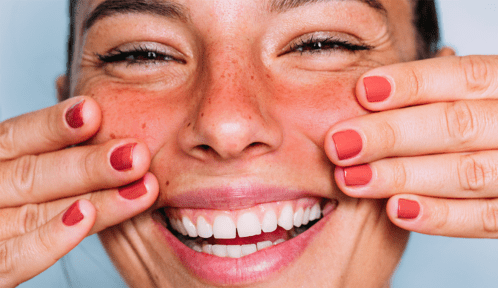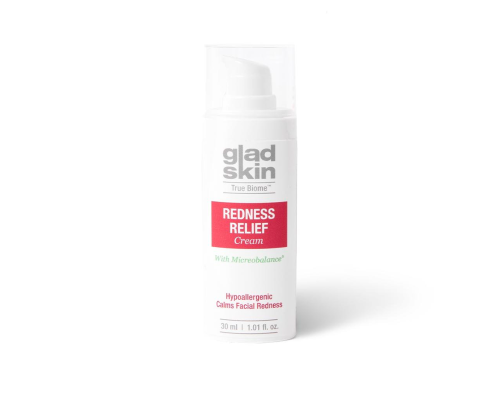advertisement
‘I’m a Dermatologist, and This Is What I Want You To Know About the Difference Between Acne and Rosacea’
The world of skin-care conditions is tough to decipher, so we tapped NYC-based derm Julia Russak to break down rosacea vs. acne.

How many times have you looked in the mirror and wondered whether that new patch of red, irritated bumps on your face is acne or… something else? And how many times have you gone down a Google rabbit hole trying to figure out what’s up—only to log off without getting any satisfying answers?
Whether you have acne, rosacea, or something else entirely, the complexity of your skin microbiome is partly responsible for the difficulty in landing on a verdict via Google. For the uninitiated, the skin microbiome is a diverse environment of bacteria that helps your skin do its job. When those bacteria are in balance, your skin looks and feels healthy. But when opportunistic bacteria overgrow, they can create inflammation, resulting in the redness and bumps you see in the mirror.
“Without a balanced skin microbiome, your skin’s immune system struggles to function properly, and skin is more easily triggered to flare,” says board-certified dermatologist Julie Russak, MD. “Acne and rosacea are both inflammatory skin conditions that are driven by imbalances of bacteria in the skin microbiome.”
In honor of Rosacea Awareness Month, we teamed up with skin-health pioneer Gladskin to ask Dr. Russak about the need-to-know differences between acne vs. rosacea so you won’t have to turn to Google to figure out what’s going on with your skin.
First up: rosacea. “Rosacea is an inflammatory condition of the skin where the immune system over-responds to internal and external stimuli,” Dr. Russak says. “Rosacea-prone skin is genetic, but rosacea’s symptoms and manifestation are really about an imbalance in the skin microbiome.” So, does it look exactly the same as acne?
According to Dr. Russak, the two conditions can look similar if you’re dealing with papulopustular rosacea (a variant commonly referred to as “acne rosacea”), which can present with inflammatory papules—aka pimples—in addition to redness, sensitivity, and swelling.
Now that we know how they’re similar, let’s dive into how to tell the difference, shall we?
Keep scrolling to learn more about rosacea vs. acne.
1. The causes of rosacea vs. acne
It’s easy to lump acne and rosacea together because they can look similar, but examining the causes sheds light on how they are different conditions.
“Acne is a disorder of the pilosebaceous unit—that’s the hair follicles and oil glands,” Dr. Russak says. “Rosacea is the result of innate immune system abnormalities that lead to inflammation in the skin.” Some types of acne can also be driven by hormones, whereas rosacea is not, she adds.
That said, acne and rosacea do have similarities: They’re both inflammatory skin conditions, and when bad bacteria overgrow, it can cause each condition to flare, Dr. Russak says.
That’s why Gladskin focuses on science-backed solutions for balancing the skin microbiome—but, more on that in a second.
Shop Skin-Care Solutions

Gladskin Blemish Gel with Micreobalance® $35

Gladskin Redness Relief Cream with Micreobalance® $35
2. The symptoms
We know that both acne and rosacea can come with pimples, but how do you know what the culprit is? Dr. Russak says to pay attention to any additional symptoms. Redness and flushing are indications your blemishes might be rosacea, while post-inflammation hyperpigmentation and scarring are caused by acne, not rosacea, she says. But, rosacea symptoms like redness can often be missed in BIPOC skin since it’s not as obvious in its physical presentation, Dr. Russak says, so it’s important to speak to a dermatologist if you’re concerned about the condition of your skin.
And if you’re wondering if you can experience both acne and rosacea, the answer is, of course, yes. “They could occur simultaneously, or at different times, and it’s also possible for them to occur on different parts of the face,” Dr. Russak says.
“If your face is flared and you’re not sure why, be sure to visit a board-certified dermatologist to ensure you get a correct diagnosis,” she says. Because an IRL doctor beats Dr. Google, every time.
3. The treatments
Finally, the part you’ve been waiting for: how to care for acne vs. rosacea. Unfortunately, people with rosacea traditionally haven’t had many options beyond prescriptions with strong ingredients and cosmetics to cover up symptoms.
Gladskin’s Redness Relief Cream with Micreobalance® takes a new approach, and offers a third option for rosacea-prone skin by restoring bacterial balance to the skin microbiome to reduce the appearance of facial redness. It also includes moisturizing and emollient ingredients, which Dr. Russak says are important for rosacea-prone skin, since it’s usually accompanied by high transdermal water loss (aka inability to retain moisture).
“Gladskin is in a category of its own: It makes your microbiome healthier, eliminates any problems with rebound, and its ingredients are gentle and well-tolerated in highly sensitive, rosacea-prone skin,” Dr. Russak says. “My patients who use Gladskin report decreased sensitivity—that means their skin is healthier [and] stronger, and that’s the best result I can ask for.”
If you are dealing with acne (and you’re sure of it now!), Gladskin has a solution for that, too. Gladskin Blemish Gel also contains Micreobalance® to help your skin start looking clearer, and it doesn’t have any harsh ingredients that can further induce inflammation.
So the next time you look in the mirror, remember this: 1. You look great. And 2. Your skin microbiome plays a big role in the health of your complexion—and hopefully understanding it a little better means less time spent Googling for skin-care solutions.
Top photo: Stocksy/Studio Firma
Sign up for the Well+Good SHOP Newsletter
Get exclusive deals on wellness, beauty, fitness, and food products that have been hand-picked by our editors.
Got it, you've been added to our email list.




